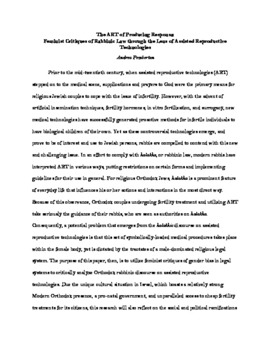| dc.description.abstract | Prior to the mid-twentieth century, when assisted reproductive technologies (ART) stepped on to the medical scene, supplications and prayers to God were the primary means for religious Jewish couples to cope with the issue of infertility. However, with the advent of artificial insemination techniques, fertility hormones, in vitro fertilization, and surrogacy, new medical technologies have successfully generated proactive methods for infertile individuals to have biological children of their own. Yet as these controversial technologies emerge, and prove to be of interest and use to Jewish persons, rabbis are compelled to contend with this new and challenging issue. In an effort to comply with halakha, or rabbinic law, modern rabbis have interpreted ART in various ways, putting restrictions on certain forms and implementing guidelines for their use in general. For religious Orthodox Jews, halakha is a prominent feature of everyday life that influences his or her actions and interactions in the most direct way. Because of this observance, Orthodox couples undergoing fertility treatment and utilizing ART take seriously the guidance of their rabbis, who are seen as authorities on halakha. Consequently, a potential problem that emerges from the halakhic discourse on assisted reproductive technologies is that this set of symbolically-loaded medical procedures takes place within the female body, yet is dictated by the tractates ofa male-dominated religious legal system. The purpose of this paper, then, is to utilize feminist critiques of gender bias in legal systems to critically analyze Orthodox rabbinic discourse on assisted reproductive technologies. Due the unique cultural situation in Israel, which boasts a relatively strong Modern Orthodox presence, a pro-natal government, and unparalleled access to cheap fertility treatments for its citizens, this research will also reflect on the social and political ramifications rabbinic rulings have on the assisted reproductive scene in Israel. Additionally, this paper will reflect on the importance of working within the halakhic system to achieve greater gender equality, and explore potential options for Orthodox feminists to realize that goal. | en_US |

